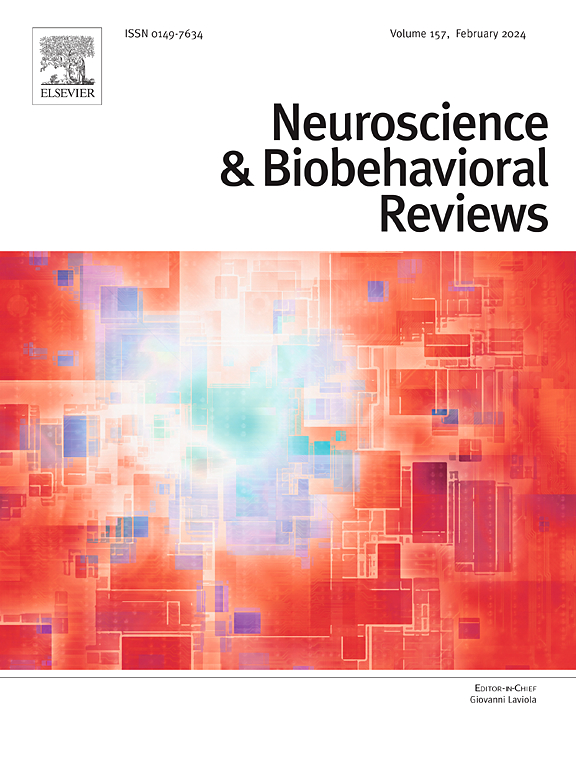偏见会计元分析方法细化和扩展,小脑行为地形。
IF 7.9
1区 医学
Q1 BEHAVIORAL SCIENCES
引用次数: 0
摘要
小脑在运动、认知和情绪行为中起着重要作用。先前的基于小脑坐标的荟萃分析(cbma)通过在最大可能的行为集合中发现可概括的小脑激活,补充了精确映射和分割方法。然而,由于固有的方法局限性,小脑cbma面临挑战,而历史上小脑在神经影像学上的忽视加剧了这一局限性。在这里,我们展示了优越激活的过度表征,使得标准激活似然估计(ALE)的零假设不合适。我们的新方法,小脑特异性ALE (C-SALE),发现行为趋同超过基线激活率。它通过测试实验激活与从数据驱动的概率分布中采样的零模型来实现这一点,这些模型可以在任何小脑位置找到激活。BrainMap元分析数据库中的任务特定映射说明了新方法的改进特异性。多个(子)区域在特定的小脑亚区收敛,支持双重运动表征,并将认知置于后外侧区域。我们证明我们的方法和发现是可复制的使用神经合成数据库。在这两个数据库中,138个任务域或行为术语中有54个在特定的小脑亚区趋同,包括持续注意、某些知觉、推理、预期和节奏。我们的meta分析图谱与小脑图谱基本一致,但也显示了许多互补的图谱。重复的亚采样分析表明,运动行为,以及较小程度上的语言和工作记忆,映射到特别一致的小脑亚区。最后,我们发现小脑簇是全脑协同激活网络的一部分,在这些行为中暗示着皮层和皮层下区域。总之,我们的方法进一步补充和扩展了对小脑参与人类行为的理解,突出了未来在基础和临床应用中的研究区域。本文章由计算机程序翻译,如有差异,请以英文原文为准。
A bias-accounting meta-analytic approach refines and expands the cerebellar behavioral topography
The cerebellum plays important roles in motor, cognitive, and emotional behaviors. Previous cerebellar coordinate-based meta-analyses (CBMAs) have complemented precision-mapping and parcellation approaches by finding generalizable cerebellar activations across the largest possible set of behaviors. However, cerebellar CBMAs face challenges due to inherent methodological limitations, exacerbated by historical cerebellar neglect in neuroimaging studies. Here, we show overrepresentation of superior activations, rendering the null hypothesis of standard activation likelihood estimation (ALE) unsuitable. Our new method, cerebellum-specific ALE (C-SALE), finds behavioral convergence beyond baseline activation rates. It does this by testing experimental activations versus null models sampled from a data-driven probability distribution of finding activations at any cerebellar location. Task-specific mappings in the BrainMap meta-analytic database illustrated improved specificity of the new method. Multiple (sub)domains reached convergence in specific cerebellar subregions, supporting dual motor representations and placing cognition in posterior-lateral regions. We show our method and findings are replicable using the NeuroSynth database. Across both databases, 54/138 task domains or behavioral terms, including sustained attention, somesthesis, inference, anticipation and rhythm, reached convergence in specific cerebellar subgregions. Our meta-analyic maps largely corresponded with cerebellar atlases but also showed many complementary mappings. Repeated subsampling analysis showed that motor behaviors, and to a lesser extent language and working memory, mapped to especially consistent cerebellar subregions. Lastly, we found that cerebellar clusters were parts of brain-wide coactivation networks with cortical and subcortical regions implied in these behaviors. Together, our method further complements and expands understanding of cerebellar involvement in human behavior, highlighting regions for future investigation in both basic and clinical applications.
求助全文
通过发布文献求助,成功后即可免费获取论文全文。
去求助
来源期刊
CiteScore
14.20
自引率
3.70%
发文量
466
审稿时长
6 months
期刊介绍:
The official journal of the International Behavioral Neuroscience Society publishes original and significant review articles that explore the intersection between neuroscience and the study of psychological processes and behavior. The journal also welcomes articles that primarily focus on psychological processes and behavior, as long as they have relevance to one or more areas of neuroscience.

 求助内容:
求助内容: 应助结果提醒方式:
应助结果提醒方式:


